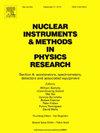非理想条件下使用绝缘体上硅像素探测器的x射线残余应力测量
IF 1.4
3区 物理与天体物理
Q3 INSTRUMENTS & INSTRUMENTATION
Nuclear Instruments & Methods in Physics Research Section A-accelerators Spectrometers Detectors and Associated Equipment
Pub Date : 2025-07-15
DOI:10.1016/j.nima.2025.170856
引用次数: 0
摘要
我们报道了电荷集成型绝缘体上硅(SOI)像素探测器INTPIX4和INTPIX4NA在非理想条件下用于x射线残余应力测量的应用。虽然这些设备可以在不到15秒的时间内测量残余应力,但它们仅在理想条件下的平面上进行了评估。在本研究中,我们检验了它们对曲面的适用性,并验证了它们对不完美衍射环的测量精度。采用cos(α)和傅里叶分析方法对残余应力进行评估。测量结果表明,当x射线辐照直径与试样直径在周向应力方向的比值小于0.5时,可以对曲面进行应力测量。在衍射环不完美的情况下,对于结晶度好的材料的衍射环,如果获得至少20°-30°的检测范围,则可以进行残余应力测量。此外,约5w的x射线强度足以测量残余应力,并且在斑点衍射环的情况下,使用平面振荡法可以提高测量精度。在全宽为半宽6.5°或更小的衍射环的钢中,残余应力可以正常测量。这些结果为该装置在曲面和不完美衍射环样品上的适用性提供了见解。我们将在今后的工作中对金属产品进行全面的评估。本文章由计算机程序翻译,如有差异,请以英文原文为准。
X-ray residual stress measurement under non-ideal conditions using silicon-on-insulator pixel detectors
We report the application of charge-integration-type silicon-on-insulator (SOI) pixel detectors, INTPIX4 and INTPIX4NA, to X-ray residual stress measurements under non-ideal conditions. Although these devices can measure residual stress in less than 1 s, they have been evaluated for only flat surfaces under ideal conditions. In this study, we examined their applicability to curved surfaces and verified their measurement accuracy for imperfect diffraction rings. The cos(α) and Fourier analysis methods were used for residual stress evaluation. The measurement results showed that the stress measurement on curved surfaces is possible when the ratio of the X-ray irradiation diameter to the specimen diameter is less than 0.5 in the circumferential stress direction. In the case of imperfect diffraction rings, residual stress measurement is possible if a detection range of at least 20°–30° is obtained for the diffraction rings of materials with good crystallinity. Furthermore, an X-ray intensity of approximately 5 W was sufficient for residual stress measurements, and the measurement accuracy can be improved using the plane oscillation method in the case of spotty diffraction rings. Residual stresses in steel with a diffraction ring with a full width at half maximum of 6.5° or less can be measured normally. The results provide insights into the applicability of the developed device to curved surfaces and samples with imperfect diffraction rings. We will conduct a comprehensive evaluation of metal products in our future work.
求助全文
通过发布文献求助,成功后即可免费获取论文全文。
去求助
来源期刊
CiteScore
3.20
自引率
21.40%
发文量
787
审稿时长
1 months
期刊介绍:
Section A of Nuclear Instruments and Methods in Physics Research publishes papers on design, manufacturing and performance of scientific instruments with an emphasis on large scale facilities. This includes the development of particle accelerators, ion sources, beam transport systems and target arrangements as well as the use of secondary phenomena such as synchrotron radiation and free electron lasers. It also includes all types of instrumentation for the detection and spectrometry of radiations from high energy processes and nuclear decays, as well as instrumentation for experiments at nuclear reactors. Specialized electronics for nuclear and other types of spectrometry as well as computerization of measurements and control systems in this area also find their place in the A section.
Theoretical as well as experimental papers are accepted.

 求助内容:
求助内容: 应助结果提醒方式:
应助结果提醒方式:


